#graminoids
Text
Getting to Know a Grass - Basic Anatomy and Identification
Have you ever tried to identify a grass? Most of us who like to look at plants and learn their names will probably admit that we often give up on grasses pretty quickly, or just ignore them entirely. They aren’t the easiest plants to identify to species, and there are so many of them. Without close inspection, they can all look pretty similar. Their flowers aren’t particularly showy, and their…

View On WordPress
#auricles#awns#botanical illustrations#botany lessons#caryopsis#cheatgrass#culms#florets#flower heads#flowers#fruits#glumes#graminoids#grass#grass collar#grasses#Kōura#leaf blades#ligule#plant anatomy#plant identification#Poaceae#quackgrass#roots#seeds#spikelets
62 notes
·
View notes
Text
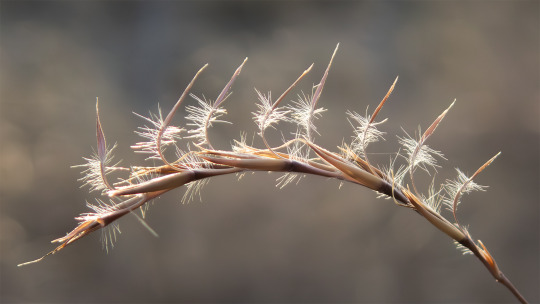
Scientific Name: Schizachyrium scoparium
Common Name(s): Little bluestem
Family: Poaceae (grass)
Life Cycle: Perennial
Leaf Retention: Deciduous
Habit: Graminoid
USDA L48 Native Status: Native
Location: Lucas, Texas
Season(s): Winter
Post-fruiting, based on season, but I’m not good at recognizing grass phenology.
#Schizachyrium scoparium#little bluestem#Poaceae#perennial#deciduous#graminoid#native#Lucas#Texas#winter#fruit#brown#tan#bluestem#plantblr
8 notes
·
View notes
Text
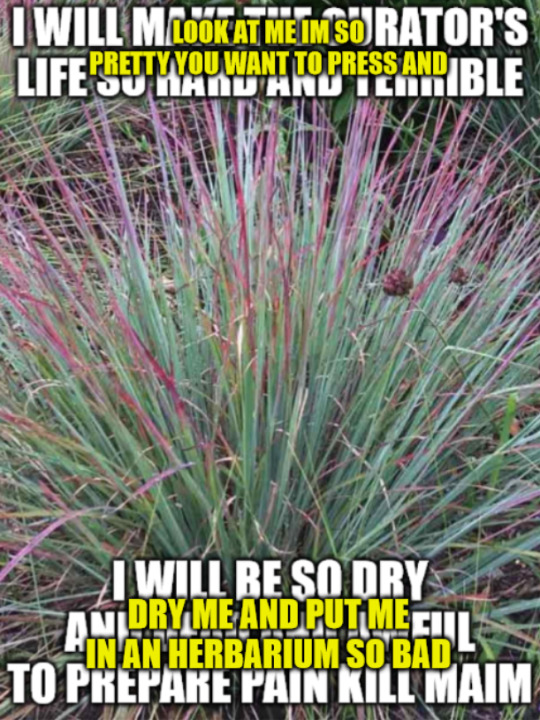
I HATE Schizachyrium scoparium SO MUCH ITS UNREAL
#botany#herbarium#IF YOU ARE COLLECTING VOUCHER SPECIMENS AND ITS ALL POACEAE/GRAMINOIDS#AND YOU SHOVE THEM ALL ONTO THE HERBARIUM STAFF IM COMINGN FOR YOUR ASS!!!!!!#its what we do but also if its your own masters thesis.........#ALSo MY herbarium has TWO paid plant mounters. ME and THE OTHER GUY#my posts
2 notes
·
View notes
Text
the Scottish highlands and the Appalachians were a part of the same mountain range 200 million years ago, so they are very similar geologically and probably have similar soil makeup as a result.
there was likely some insane ecological disruption from the Death Stranding (the persistence of timefall, I guess) that elicited a bonkers case of primary succession and turned the Eastern US into the sparsely-wooded, graminoid-dominated landscape we see in the game (that looks strikingly similar to the Scottish highlands).
it's also mentioned that timefall is used to grow wheat due to its freaky properties. not exactly sure how, but I have to take a look at the interview logs again. fascinating stuff.
#death stranding#speculative biology#speculative ecology#?#worldbuilding#ALSO I thought the basalt columns in the central US were kinda goofy but! rhyolite columns do exist in missouri so!#I hc them as rhyolite columns affected by timefall somehow lol
2 notes
·
View notes
Text
Grass is a plant with narrow leaves growing from the base. A common kind of grass is used to cover the ground in a lawn and other places. Grass gets water from the roots in the ground. Grass is usually pigmented with the colour ‘green’. Grasses are monocotyledon, herbaceous plants.
The grasses include the "grass", of the family Poaceae (also called Gramineae). Also sometimes it is used to include the sedges (Cyperaceae) and the rushes (Juncaceae). These three families are not closely related but belong to different clades in the order Poales. They are similar adaptations to a common life-style.
The true grasses include cereals, bamboo and the grasses of lawns (turf) and grassland. Uses for graminoids include food (as grain, sprouted grain, shoots or rhizomes), drink (beer, whisky), pasture for livestock, thatching thatch, paper, fuel, clothing, insulation, construction, sports turf, basket weaving and many others.
Many grasses are short, but some grasses, like bamboo can grow very tall. Plants from the grass family can grow in many places, even if they are very cold or very dry. Several other plants that look similar but are not members of the grass family are also sometimes called grass; these include rushes, reeds, papyrus, and water chestnut.
Grasses are an important food for many animals, like deer, buffalo, cattle, mice, grasshoppers, caterpillars, and many other grazers. Unlike other plants, grasses grow from the bottom, so when animals eat grass they usually do not destroy the part that grows. Without grass, dirt can wash away into rivers (erosion). Graminoids include some of the most versatile plant life-forms. They became widespread toward the end of the Cretaceous. Fossilized dinosaur dung (coprolites) have been found containing grass phytoliths (silica stones inside grass leaves). Grasses have adapted to conditions in lush rain forests, dry deserts, cold mountains and even intertidal habitats, and are now the most widespread plant type. Grass is a valuable source of food and energy for many animals.Lawn grass is often planted on sports fields and in the area around a building. Sometimes chemicals and water is used to help lawns to grow.
People have used grasses for a long time. People eat parts of grasses. Corn, wheat, barley, oats, rice and millet are cereals, common grains whose seeds are used for food and to make alcohol such as beer.
Sugar comes from sugar cane, which is also a plant in the grass family. People have grown grasses as food for farm animals for about 4,000 years. People use bamboo to build houses, fences, furniture and other things. Grass plants can also be used as fuel, to cover roofs, and to weave baskets. n English, the word "grass" appears in several phrases. For example: "The grass is always greener on the other side" means "people are never happy with what they have and want something else." "Don't let the grass grow under your feet" means "Do something". "A snake in the grass" is about a person that will not be honest and will trick others.
Grass is sometimes used as a slang term for cannabis (also called pot, weed, or marijuana) The Grass type (Japanese: くさタイプ Grass type) is one of the eighteen types. Prior to changes in Generation IV, all damaging Grass-type moves were special, but they may now also be physical depending on the attack. Grass-type Pokémon are immune to Leech Seed. Grass-type Pokémon are immune to Leech Seed Starting in Generation VI, Grass-type Pokémon are immune to powder and spore moves and Effect Spore.Grass types are tied with Rock in having the most weaknesses out of all types with five. Since Generation I, a particular asset of Grass types is being the only type that is immune to Leech Seed. As of Generation VI, Grass-type Pokémon are also immune to powder and spore moves, such as Sleep Powder and Stun Spore. Additionally, Grass Pokémon are the only ones affected by Rototiller and Flower Shield. Those moves raise both attack stats or the physical Defense stat, respectively, when used. Forest's Curse adds the Grass type to the target's types. Grass-type attacks are resisted by seven types, so they're tied with Bug as the most resisted type. Those resistant types are best covered by Rock and Ground. As of Generation VI, Dark and Ghost have neutral matchups against every type that resists Grass. When Grassy Terrain is in the effect, the power of Grass-type moves is increased by 30% (50% prior to Generation VIII) if the user is on the ground.
Contest properties In contests, Grass-type moves are typically Clever moves, but can also be any of the other four contest conditions. As of Generation VIII, there are 112 Grass-type Pokémon or 12.27% of all Pokémon (counting those that are Grass-type in at least one of their forms), making it the third most common type after Normal and before Flying.
A Pokémon with Protean or Libero will become a Grass-type Pokémon if it uses a Grass-type move. A Pokémon with Color Change, Imposter, Mimicry, RKS System, or Multitype will become a Grass-type Pokémon if (respectively) it is hit with a Grass-type move, is sent out against a Grass-type opponent, if the terrain is grassy, if it is holding a Grass Memory, or if it is holding a Meadow Plate or Grassium Z. Since Generation VI, Grass-type Pokémon are also immune to Effect Spore; Only Grass-type Pokémon can have these Abilities. This does not include signature Abilities.Due to the decreased amount of types in the TCG, Grass generally adopts all Bug-type Pokémon under its typing. It also adopted Poison-type Pokémon prior to the Diamond & Pearl set, after which they were moved to Psychic. Similar to the games, Grass-type Pokémon in the TCG are generally weak to Fire and resist Water.
Grass-type Pokémon are strong against Fighting and Water Pokémon, whilst Metal Pokémon resisted it until the EX Power Keepers expansion set. Generation V introduced the most Grass-type Pokémon of any generation, with 21 (including Rotom's Mow form), and Generation VI introduced the fewest Grass-type Pokémon, with nine. Generation I introduced the most Grass-type moves of any generation, with 10, and Generation II introduced the fewest Grass-type moves, with three.
The Grass type and/or Pokémon of the type have been referred to using the term "plant" instead on some occasions: In the English Generation I games, the Gym guide in Cerulean Gym refers to Pokémon of the Grass type as "plant Pokémon". In the English versions of Pokémon FireRed and LeafGreen, he instead mentions "Grass-type Pokémon". In the Japanese versions of the Generation I games and FireRed and LeafGreen, he mentions the Grass type itself, calling it the "Plant type" (Japanese: しょくぶつタイプ). Another reference to "plant Pokémon" (Japanese: しょくぶつポケモン) is made by Professor Oak in the Japanese Pokémon Red, Green, and Blue, and international Pokémon Red and Blue, classifying Bulbasaur as such when the player is about to choose it as their starter. This is also the case in the Japanese versions of Pokémon FireRed and LeafGreen; in contrast, he calls it the "grass Pokémon" in the English versions. This same reference is also used in the first episode of Pokémon Origins.
In multiple languages, such as French and German, the Grass type is translated as the Plant type. The Turkish dub of the anime occasionally refers to "Grass type" as "Plant type". The Grass type has the most Pokémon that evolve by Evolution stones, with a total of 11. It is also the type that can utilize the most stones, having at least one Pokémon that can evolve via the Leaf Stone, Sun Stone, Water Stone, and Shiny Stone.The Grass type is the only type to have more than one HP-draining move, having five of them. Grass-type attacks deal doubly super-effective damage to the most Pokémon of all types. Grass-type attacks are super effective against the three types that Fire types are weak to. Fire is the only type that hasn't been paired with Grass. In Tree's a Crowd, Brock states that Grass-type Pokémon resist Electric-type moves due to being able to diffuse the electricity into trees and the ground. He also explains that if Grass types are in the air, they cannot diffuse the electricity from Electric attacks, thereby dealing normally effective damage.
Now that you have read this much about grass, maybe you should go and touch some...
5 notes
·
View notes
Note
Eww why are accepting roleplayers? They suck and they live in a y/n world. You could've used that time to study rest of the characters so u don't have just sakamakis within this blog. Ur blog sucks bitch!! Leave DL!!
Grass
What is grass?
Grass is a type of plant with narrow leaves growing from the base. A common kind of grass is used to cover the ground in places such as lawns and parks. Grass is usually the color/colour ‘green’. Grasses are monocotyledon herbaceous plants.
The grasses include the "grass" of the family Poaceae. This family is also called Gramineae. The family also include some of the sedges (Cyperaceae) and the rushes (Juncaceae). These three families are not closely related but all of them belong to clades in the order Poales. They are similar adaptations to a common life-style.
The true grasses include cereals, bamboo and the grasses of lawns (turf) and grassland. Uses for graminoids include food (as grain, sprouted grain, shoots or rhizomes), drink (beer, whisky), pasture for livestock, thatching thatch, paper, fuel, clothing, insulation, construction, sports turf, basket weaving and many others.
Many grasses are short, but some grasses can grow very tall, such as Bamboo. Plants from the grass family can grow in many places and make grasslands, including areas which are very arid or cold. There are several other plants that look similar to grass and are referred to as such, but are not members of the grass family. These plants include rushes, reeds, papyrus and water chestnut. Seagrass is a monocot in the order Alismatales.
Grasses are an important food for many animals, such as deer, buffalo, cattle, mice, grasshoppers, caterpillars and many other grazers. Unlike other plants, grasses grow from the bottom, so when animals eat grass they usually do not destroy the part that grows. This is a part of why the plants are successful. Without grass, soil may wash away into rivers (erosion).
CONCLUSION: Touch some grass. ❤
ok ok, jokes aside, its not that hard to be nice to other ppl who send in their asks. we are aware that not everyone likes rp asks which is why they are tagged appropriately, dont like it, dont read it. simple. if you have the courage, get off of anon mode. clearly in the rules it states to be nice to everyone, if you are not going to follow our rules purposefully (not accidentally, pretty obv that you said it intentionally) dont interact 🖤
3 notes
·
View notes
Text
How to glitch off female Genshin charcters clothes
Why tf you still here 😐 📸

Grass is a plant with narrow leaves growing from the base. A common kind of grass is used to cover the ground in places such as lawns and parks. Grass is usually the color/colour ‘green’. Grasses are monocotyledon herbaceous plants.
The grasses include the "grass" of the family Poaceae. This family is also called Gramineae. The family also include some of the sedges (Cyperaceae) and the rushes(Juncaceae).[1] These three families are not closely related but all of them belong to clades in the order Poales. They are similar adaptations to a common life-style.
The true grasses include cereals, bamboo and the grasses of lawns (turf) and grassland. Uses for graminoids include food (as grain, sprouted grain, shoots or rhizomes), drink (beer, whisky), pasture for livestock, thatching thatch, paper, fuel, clothing, insulation, construction, sports turf, basket weaving and many others.
Many grasses are short, but some grasses can grow very tall, such as Bamboo. Plants from the grass family can grow in many places and make grasslands, including areas which are very arid or cold. There are several other plants that look similar to grass and are referred to as such, but are not members of the grass family. These plants include rushes, reeds, papyrus and water chestnut. Seagrass is a monocot in the order Alismatales.
Grasses are an important food for many animals, such as deer, buffalo, cattle, mice, grasshoppers, caterpillars and many other grazers. Unlike other plants, grasses grow from the bottom, so when animals eat grass they usually do not destroy the part that grows.[2] This is a part of why the plants are successful. Without grass, soil may wash away into rivers (erosion).
2 notes
·
View notes
Text
Grass is a plant with narrow leaves growing from the base. A common kind of grass is used to cover the ground in places such as lawns and parks. Grass is usually the colour ‘green’. Grasses are monocotyledon, herbaceous plants.
The grasses include the "grass", of the family Poaceae (also called Gramineae). Also sometimes it is used to include the sedges (Cyperaceae) and the rushes (Juncaceae). These three families are not closely related but belong to different clades in the order Poales. They are similar adaptations to a common life-style.
The true grasses include cereals, bamboo and the grasses of lawns (turf) and grassland. Uses for graminoids include food (as grain, sprouted grain, shoots or rhizomes), drink (beer, whisky), pasture for livestock, thatching thatch, paper, fuel, clothing, insulation, construction, sports turf, basket weaving and many others.
Many grasses are short, but some grasses, like bamboo can grow very tall. Plants from the grass family can grow in many placesans make grasslands, even if they are very cold or very dry. Several other plants that look similar but are not members of the grass family are also sometimes called grass; these include rushes, reeds, papyrus, and water chestnut. Seagrass is a monocot in the order Alismatales.
Grasses are an important food for many animals, like deer, buffalo, cattle, mice, grasshoppers, caterpillars, and many other grazers. Unlike other plants, grasses grow from the bottom, so when animals eat grass they usually do not destroy the part that grows. Without grass, earth may wash away into rivers (erosion).
6 notes
·
View notes
Note
Lets talk about grass, Nature's huge carpet Grass is a type of plant with narrow leaves growing from the base. Their appearance as a common plant was in the mid-Cretaceous period. There are 12,000 species now.[3] A common kind of grass is used to cover the ground in places such as lawns and parks. Grass is usually the color green. That is because they are wind-pollinated rather than insect-pollinated, so they do not have to attract insects. Green is the best colour for photosynthesis. Grasslands such as savannah and prairie where grasses are dominant cover 40.5% of the land area of the Earth, except Greenland and Antarctica.[4] Grasses are monocotyledon herbaceous plants. They include the "grass" of the family Poaceae, which are called grass by ordinary people. This family is also called the Gramineae, and includes some of the sedges (Cyperaceae) and the rushes (Juncaceae).[5] These three families are not very closely related, though all of them belong to clades in the order Poales. They are similar adaptations to a similar life-style. With about 780 genera and about 12,000 species,[3] the Poaceae is the fifth-largest plant family. Only the Asteraceae, Orchidaceae, Fabaceae and Rubiaceae have more species.[6] The true grasses include cereals, bamboo and the grasses of lawns (turf) and grassland. Uses for graminoids include food (as grain, shoots or rhizomes), drink (beer, whisky), pasture for livestock, thatch, paper, fuel, clothing, insulation, construction, sports turf, basket weaving and many others. Many grasses are short, but some grasses can grow tall, such as bamboo. Plants from the grass family can grow in many places and make grasslands, including areas which are very arid or cold. There are several other plants that look similar to grass and are referred to as such, but are not members of the grass family. These plants include rushes, reeds, papyrus and water chestnut. Seagrass is a monocot in the order Alismatales. Grasses are an important food for many animals, such as deer, buffalo, cattle, mice, grasshoppers, caterpillars and many other grazers. Unlike other plants, grasses grow from the bottom, so when animals eat grass they usually do not destroy the part that grows.[7] This is a part of why the plants are successful. Without grass, soil may wash away into rivers (erosion).
That is interesting I feel like grass should be talked and appreciated more (I read nothing)
1 note
·
View note
Text

Grass is a type of plant with narrow leaves growing from the base. Their appearance as a common plant was in the mid-Cretaceous period. There are 12,000 species now.[3]
A common kind of grass is used to cover the ground in places such as lawns and parks. Grass is usually the color green. That is because they are wind-pollinated rather than insect-pollinated, so they do not have to attract insects. Green is the best colour for photosynthesis.
Grasslands such as savannah and prairie where grasses are dominant cover 40.5% of the land area of the Earth, except Greenland and Antarctica.[4]
Grasses are monocotyledon herbaceous plants. They include the "grass" of the family Poaceae, which are called grass by ordinary people. This family is also called the Gramineae, and includes some of the sedges (Cyperaceae) and the rushes (Juncaceae).[5] These three families are not very closely related, though all of them belong to clades in the order Poales. They are similar adaptations to a similar life-style.
With about 780 genera and about 12,000 species,[3] the Poaceae is the fifth-largest plant family. Only the Asteraceae, Orchidaceae, Fabaceae and Rubiaceae have more species.[6]
The true grasses include cereals, bamboo and the grasses of lawns (turf) and grassland. Uses for graminoids include food (as grain, shoots or rhizomes), drink (beer, whisky), pasture for livestock, thatch, paper, fuel, clothing, insulation, construction, sports turf, basket weaving and many others.
Many grasses are short, but some grasses can grow tall, such as bamboo. Plants from the grass family can grow in many places and make grasslands, including areas which are very arid or cold. There are several other plants that look similar to grass and are referred to as such, but are not members of the grass family. These plants include rushes, reeds, papyrus and water chestnut. Seagrass is a monocot in the order Alismatales.
Grasses are an important food for many animals, such as deer, buffalo, cattle, mice, grasshoppers, caterpillars and many other grazers. Unlike other plants, grasses grow from the bottom, so when animals eat grass they usually do not destroy the part that grows.[7] This is a part of why the plants are successful. Without grass, soil may wash away into rivers (erosion).
1 note
·
View note
Text
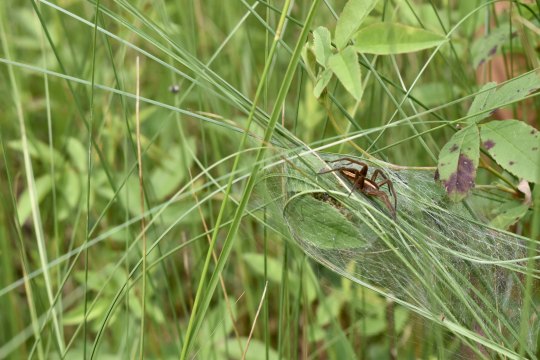
Kitty Todd Spider by Josh Gross
Via Flickr:
A spider that I saw during a graminoid (grass, rush, and sedge) workshop at Kitty Todd Nature Preserve near Toledo, Ohio.
#cw arachnophobia#cw arachnid#cw spider#kitty todd nature preserve#swanton ohio#lucas county#et in americana ego#spider
0 notes
Photo

Scientific Name: Chasmanthium latifolium
Common Name(s): Inland sea oats, inland wood oats
Family: Poaceae (grass)
Life Cycle: Perennial
Leaf Retention: Deciduous
Habit: Graminoid
USDA L48 Native Status: Native
Location: Plano, Texas
Season(s): Fall
When I first heard the name “inland sea oats,” I wondered if it was an oat that grew near an inland sea or if it was some variant of a sea oat that grew inland. Short answer: it’s the latter. Sort of. Then it gets complicated. For starters, there are more names. This plant must’ve hit the jackpot in the common name lottery, because, in addition to inland sea oats and inland wood oats, it’s also called river oats, wood oats (without the “inland”), Indian wood oats, upland oats, wild oats, northern sea oats, plus regional variations, and endless permutations of all these.
This is a shade-tolerant plant native to the southeastern U.S., as shown by the green-tinted areas in the USDA map below. It is found along riverbanks, on floodplains, and in bottomland forests, giving rise to the names “river oats” and “wood oats.”
Its seedheads resemble those of sea oats (Uniola paniculata), which grows on coastal sands. However, since this species is not a coastal plant, the combination of its similar appearance but dissimilar habitat get mashed together into the awkward name “inland sea oats.” As both of these plants were once classified under the same genus (Uniola), it’s not clear to me if they’re as genetically distinct as the separate genera would suggest. So the slightly longer answer to my original question is: it’s a maybe, maybe-not sea oat that grows inland.
However, neither plant has ever been associated with Avena, which is the genus to which our breakfast oats belong. I thnk using the name “wild oats” on this plant is just going to cause confusion, because the farmed oat (Avena sativa) has a wild relative (Avena fatua), and its common name is — wait for it — wild oat.
It should be clear by now that common names can be unreliable, but perhaps the most nonsensical one here is “northern sea oats,” because this species is not native to the north, not a seaside plant, and not an oat. How anyone came up with that name is a complete mystery to me.

#Chasmanthium latifolium#inland sea oats#inland wood oats#Poaceae#perennial#deciduous#graminoid#native#Plano#Texas#fall#autumn#fruit#brown#tan#plantblr
6 notes
·
View notes
Text
Yesterday we were planting three species of graminoids in a row (in a yellow conetainer, black conetainer, and a 4 inch pot depending on species) and I was like lol, I did set the plants out in an order but it really doesn't matter. But when the cones weren't stacked black-yellow-black-yellow I had to talk myself out of rearranging them 😭
0 notes
Text
Yellowstone Grizzly Bears
The grizzly bears in the Yellowstone ecosystem are opportunistic omnivores, and they consume a considerable diversity of animal and plant species. According to the United States Geological Survey (USGS), grizzly bears in the Yellowstone area have been found to consume about 266 species of plants, which account for 67% of their diet. They also consumed about 37 different species of invertebrates which account for 15% of their diet and about 34 different species of mammals which account for 11% of their diet. These bears also consume fungi, birds, fish, amphibians, algae, and soil. Their frequently consumed diet includes graminoids, ants, nuts of the whitebark pine, clovers, and dandelion.
dirt????? dirt??????
0 notes
Text
A passionate complaint
Today was an interesting day full of conversations. One of the fantastic endeavours of humankind has been to become more social - which I am by my habit have been quite not good at. However, over the course of the life into the adulthood I have made a few select group of friends and acquaintances with whom I share great pleasure of connecting and conversing around vastly different topic. Although, due to the nature of growth and life as it is, friends and family often spread around the world with quite a physical distance among themselves. This, however, does not equal to further distance between heart and connection. On the contrary, it leads to a strengthening of that connection via memory, nostalgia, and the gratitude for all the pleasured and treasured moments shared with that person.
One of such friends of mine is currently pursuing her PhD in Australia. This is a country where many known faces to me resides, despite its location on entirely different hemisphere of dear planet of ours. With the complete opposite seasonal sequence, abrupt weather trends, sparse human population with double the kangaroo population - many of my fellow acquaintances have made that country their temporary 'home'. So, the friend of mine and I sat together, connected via the magical ether of internet, to catch up after many busy fortnights of surviving through our respective lives.
It is always a pleasure to strike up a trade of words with someone thinking in the same spectrum. The friend and I, by the virtue of being friends over the tumultuous years of undergraduate education, have shared many events of happiness and sorrow, excitements and dreariness, and peace and chaos. So, of course, our spectrums of thoughts have tuned themselves quite beautifully - so much so even the garbled words and flickers of eyebrows can convey meanings. Hence when we connected after so long, a spark of conversation was lit - and the flame fanned out as the hours passed.
True to the millennial traditions, came the complaining. To be truthful they were consistently spread around the conversation as life has been too unkind sometimes. However, a particular part of conversation was a true passionate 'complaint' of mine. It regards the human nature of interest, and the lack thereof.
Curiosity killed the cat. Then it discovered fire, clothing, music, language, commerce, glass, tobacco, wine, pickled gherkins, artificial sweeteners, penicillin, radio, radioactivity, stars, planets, object beyond our solar system, black holes, potholes, wildlife, agriculture, noodles, chopsticks, cassettes, electricity, light bulb, the computer, internet, and many things in between. While doing so humans also kept being curious about the cat and asking if the cat was killed or left alive. Among all the curiosities one can develop, the most unfulfilling, vicious, unproductive, and appalling one is the curiosity about other people's life. The nosiness of gossip constantly rubs our noses in dirt, and we keep being quaintly oblivious to that. Always comparing even though humans always lead a completely different life from one another and will always do so - despite the similarities one may find with others. Always judging as if a supreme being bestowed the responsibility of divine judgement of right and wrong upon our tiny brain which can't even comprehend the true complexity of our nature. The grass is greener on the other side, or so we say. Which, through experience, I learnt is completely false. The grass is not greener on the other side. In fact, the other side probably do not have grass at all. For some, the herbaceous growth you see on the other side may be sedges not grasses. The nerd inside me is urging to tell you that sedges belong to the family of graminoids - grass like plants. So, looking for similarities are pointless. Also, chaos theory describes that the simplest change in the starting state can result in a vastly different result in the final states. Human lives in its starting state always vastly differs from each other. The final or intermittent steps where we place our judgement is so far different than our supercharged thinking machines can even remotely comprehend. Yet we do pass our judgement, we put behavioural characteristics and label them. This practice seems to be the dullest, and fruitless endeavours of all time. I do accept that I have not considered the entire set of endeavours of all time, but I am sure you get my point.
There is another set of people who live in the spectrum of not having any sort of interest - or the intensity of interest that we call passion. However, I grown to realise that it may not be their own fault. Life is not set to be fair or kind or anything of that sort in the reality. Through the time, circumstances, experiences, and opportunities shape the human desires, activities, interests, and thought process. Often the harshness of survival leaves no space for the growth of an interest - like a harsh winter seizes any attempt of growth of a plant in the Tundras. Some do regain their lost spirit or develop new ones when life’s harshness is subsided by various means, and the ease and freedom of exploration set in. For many though, the mental barrier developed over the years becomes a too tall of a wall for climbing and crossing. There is also an additional barrier in the current world that hinders the growth of interest or passion: the modern life of connectivity. The information overload and the dumping of garbage materials on otherwise healthy mind often renders them numb to sensation of curiosity, passion, and discovery. The depletion of dopamine reserve through mindless scrolling of infinite stream of media, clickbaits, and cat videos leaves no enthusiasm left for critical thinking or thinking of any sorts. Quite enchanted by the urge of dopamine hits we live a life of digital zombies. The hard work to build a passion often is just too much for many of our generation and upcoming ones.
The void of or corruption of interest – however you see it – is a quite serious plaguelike event that is, to be frank, always have been a part of human society. In the earlier civilisations too, I believe, these were present. Look at the myths of civilisations and you will see even the Olympians and the offspring gods were not devoid of the viced interest of gossips and jealousy nor they were free of the lack of serious pursuit of interest. Depends on whom you look at one or the other vice will be present. If we think that man provisioned the tales of the gods with their own understanding of behaviours – it obviously makes sense to think that the earlier civilisations also had the same experience.
The intensity with which most of us look outwards and measure other people’s lives, could have been actually beneficial if only the gaze went inwards into the life we own. However, the chaotic and often unsettling nature of self-reflection repels most of us away from such activity. The ones who can take in the pain, master the gaze, reflect, and act – are the ones we can call the true enlightened ones.
0 notes
Photo
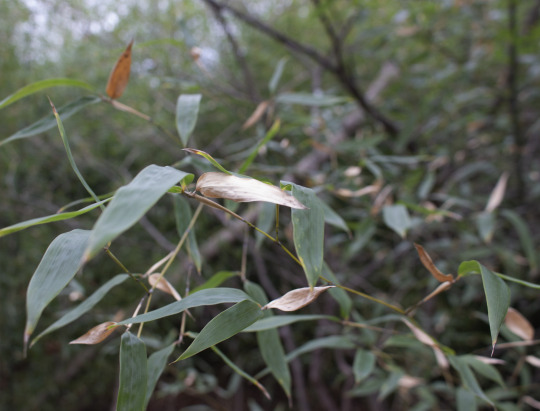

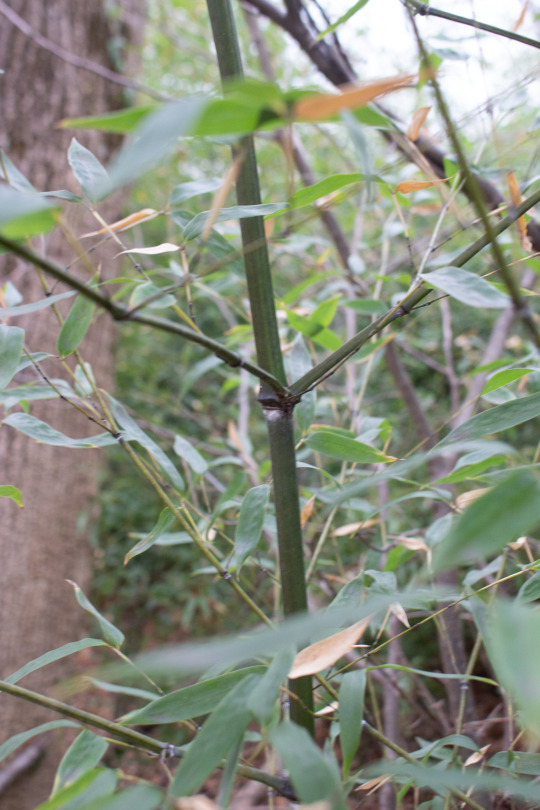
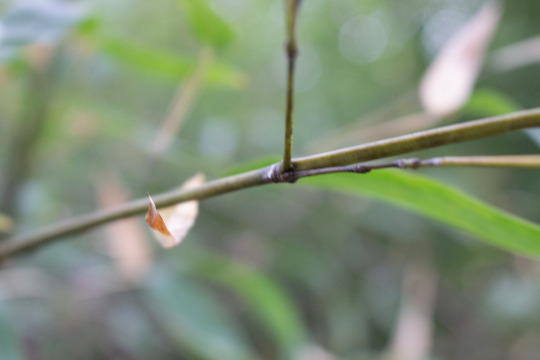

Phyllostachys aurea
“Golden Bamboo”
Location: Charlestown, PA
Golden bamboo is often used as a hedge or screening bush for privacy. Canes turn yellow with exposure to sun and deepen to gold-orange as the plant matures. A nonnative plant in North America, this bamboo often overtakes many native species and can lead to imbalance in an ecosystem.
Solar Exposure: Full sun to partial shade
Hardiness Zones: 4-8
Preferred Soil: Loam; well drained; slightly acidic to slightly alkaline
(Source: PictureThis Plant ID app)
0 notes